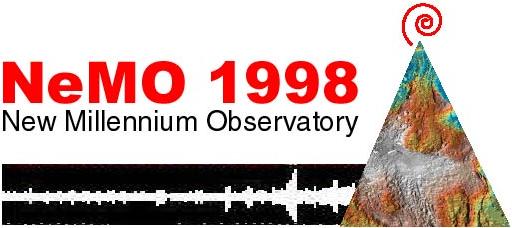WHAT'S NEW:
Eruption Confirmed!
New lava (rumbleometer stuck in flow) SE rift zone
(posted 9/1/98)
BACKGROUND:
Technology (ROV, ships, etc.)
Other 1998 Axial cruise reports
EXPEDITION:
Science Objectives
Calendar
Today's Science News
Participant Perspective
Teacher Logbook
EDUCATION:
Curriculum
Teacher Observations
Questions/Answers from sea
MULTIMEDIA:
(video clips, animations, sounds)

Preliminary Plan for the 1998 NeMO Expedition
The 1998 NeMO expedition will be on board the NOAA ship Ron Brown from August 24 to September 20. The ROV ROPOS will be the primary tool for observing and sampling the seafloor as well as for manipulating other instrumentation.
The research cruise consists of 23 dive days and 3 transit days. Below is a summary of the scientific objectives that were funded by the supporting agencies. In addition to these goals, there will be interest in documenting any changes resulting from the earthquake swarm and intrusion/eruption that occurred at Axial in January 1998.
The scientific research during the NeMO cruise is multi-disciplinary. That means that scientist from many different fields (geology, chemistry, biology, oceanography, geophysics) are all working together toward a set of common goals. Nevertheless, specific objectives can be broken down by discipline:
- Chemistry/Microbiology of Subsurface Biosphere
- Macrobiology/Ecology
- Microbiology Processes at Vents
- Geology/Hydrothermal Linkages
Goals by Discipline:
Chemistry/Microbiology of Subsurface Biosphere
(Butterfield, Baross, Massoth, Kaye, Wheat, Jannisch, Moyer)The chemistry program aims to find relationships between the temperature and chemical composition of selected hydrothermal vents with the kind of microorganisms thriving in them. The specific aim is to understand what the subsurface environment is like.
Objectives & key questions:
1) Define geochemical niches in different hydrothermal vent sites.
2) Look for evidence of chemical reaction or metabolism by microorganisms within hydrothermal fluid samples.
3) Culture microbes from well-characterized environments.
4) Assess diversity and population structure by genetic techniques.
5) Relate chemistry and microbiology to geological structure and plumbing system.
Measurements Planned:
Shipboard:
SUAVE in situ: CTD, Fe, Mn, H2S, (pH)
Discrete shipboard: H2S, Si(OH)4, NH3, pH
Ion Chromatograph: Cl, SO4 , Li, Na, K, Mg, Ca
Organic acids (formate, acetate, propionate)
Critical volatiles (H , O , CH , CO ) by GC (B. McLaughlin)
On shore:
Transition metals and trace elements, frozen samples for NO3, DOC (at UW)
He and rare gases (Lupton)
Sr isotopes (with B. Nelson UW)
Particulate elemental concentrations and particle morphologies by XRF and SEM
POC
Isotopes of C, N, S
Other organic compounds
Monitoring:
Osmosamplers (Year-long deployments)
SUAVE (short-term deployment)
Requirements:
Extensive use of fluid sampler, SUAVE
Deployment of osmosamplers
Macrobiology/Ecology
(Tunnicliffe, Tsurumi, Marcus, Juniper, Massoth)The microbiology/ecology program will focus on the communities of larger animals that live in and around hydrothermal vent sites.
Objectives and key questions:
General:
1) What is the role of system stability: vent community diversity compared to CoAxial and Cleft?
2) What are the local diversity patterns with respect to geological and chemical gradients
??
3) What are the metapopulation dynamics in the caldera?
4) How do biota and chemistry covary?
Specific:
1) Diversity of the Axial Seamount vent communities:
Does Species composition vary markedly over the four major Axial sites?
How does the Axial species pool compare to Cleft and CoAxial?
What does temporal variability look like at Axial?
2) Community structure with respect to water parameters:
Correlate information on water/microbial conditions and animal distribution over the caldera
initial focus on the polychaetes as they display variability over the seamount
Requirements:
Sampling of animals exactly where chemical parameters examined
Microbial Processes at Vents
(Juniper, Massoth, Grelon, Tunnicliffe, Levesque, Southward, Scott, Huff, Moyer)The microbiology program will characterize the different vent habitats above the seafloor and relate this to the microorganisms living there.
Processes:
1) Habitat conditions and behavior of sulphide worms
Goals:
Map high temperature habitat with SUAVE
Collect spires
Video surveys
Requirements:
20 scans
30 min. Video
Time-lapse camera deployment for a day or two
2) Microbial Sampler
Goals:
Measure low-temperature microbial abundance and diversity
Important aspect of vent community characterization
Requirements:
Some time for testing and adjusting system, in conjunction with SUAVE surveys
3) Habitat Variation and Stable Isotopes
Goals:
Interpret ranges of C and N isotopes in select species in different conditions of venting
Requirements:
Collection of faunal samples where SUAVE and/or fluid samples taken (also fits with Tunnicliffe group goals)
4) Biomineralization Processes
Goals:
Mineral, chemical, and microbial characterization of oxide mounds around ASHES
Mapping of mounds
Requirements:
SUAVE, time for collection of samples (with PacMan, Slurpgun, manipulator)
Geological/Hydrothermal Linkages
(Embley, Chadwick, others)The geology program will look at the different kinds of geologic structures that host hydrothermal vents.
Goals:
(1) Document relationships between volcanic activity, tectonic setting and temporal evolution of hydrothermal systems
(2) Measure effects of diking on horizontal strain field and hydrothermal system
(3) Look for relationships between seismicity and temperature changes at hydrothermal vents
Tasks:
1) Detailed mapping of several hydrothermal systems at the summit of Axial, including:
- the southwest wall (ASHES and vicinity)
- upper south rift zone
- the junction between east caldera wall and south rift zone
- the upper north rift zone
- the CASM site
Dedicated dive time, surveys done up to 10-30 meters altitude using digital camera and scanning sonar with good navigation
2) Time-series of horizontal strain changes on Axial Rift zone(s)
Survey 1996-98 site of extensometer deployment
Recover extensometers plus refurbish
Redeploy 5 extensometers (1 year), probably at same site
Requirements:
Dedicated dive time, elevator to recover and redeploy extensometers
3) Geologic/hydrothermal time series
Look at nature of and coherence of temperature changes in selected hydrothermal vents with seismicity (recorded during a separate OBS experiment by SIO researchers) Do earthquakes cause changes in the output of individual vents?
Requirements:
Deployment of 4 HOBO probes (hi-temp), and up to 10 low-temp probes at diffuse vents at range of geologic settings and over maximum spatial separation (some may be put in with ALVIN in July)
- Additionally, activities not requiring the ROV (during down time):
- a rock-coring program
- mooring deployments
- CTD (conductivity/temperature/depth) casts or tows
- multibeam bathymetric surveys